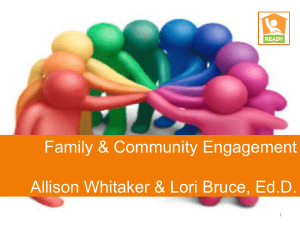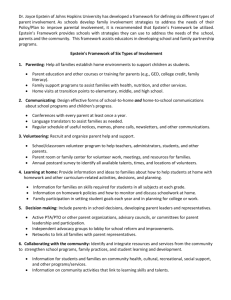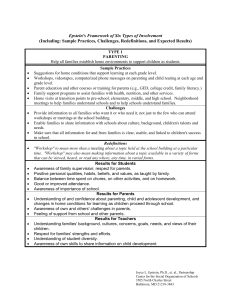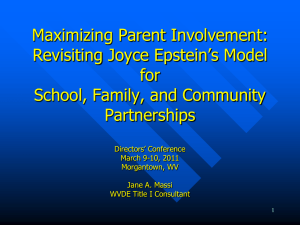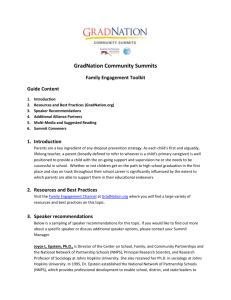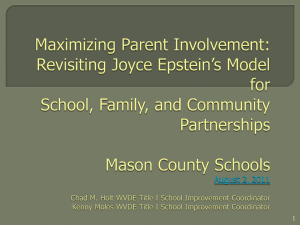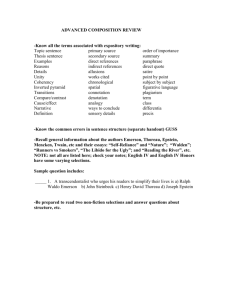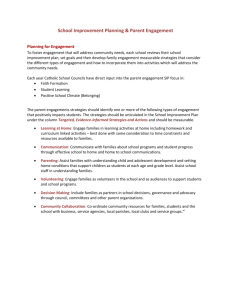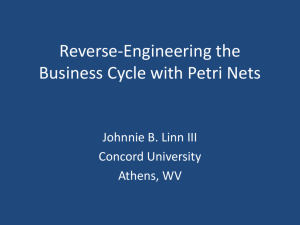Epstein's 6 Types of Parent Involvement Framework
advertisement
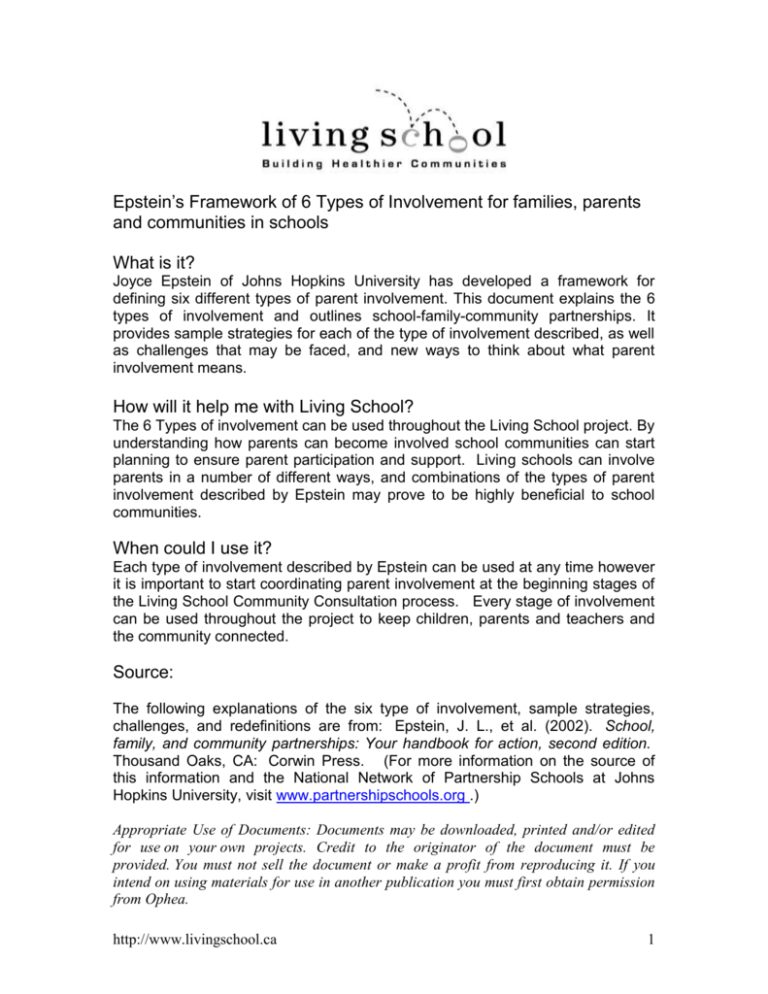
Epstein’s Framework of 6 Types of Involvement for families, parents and communities in schools What is it? Joyce Epstein of Johns Hopkins University has developed a framework for defining six different types of parent involvement. This document explains the 6 types of involvement and outlines school-family-community partnerships. It provides sample strategies for each of the type of involvement described, as well as challenges that may be faced, and new ways to think about what parent involvement means. How will it help me with Living School? The 6 Types of involvement can be used throughout the Living School project. By understanding how parents can become involved school communities can start planning to ensure parent participation and support. Living schools can involve parents in a number of different ways, and combinations of the types of parent involvement described by Epstein may prove to be highly beneficial to school communities. When could I use it? Each type of involvement described by Epstein can be used at any time however it is important to start coordinating parent involvement at the beginning stages of the Living School Community Consultation process. Every stage of involvement can be used throughout the project to keep children, parents and teachers and the community connected. Source: The following explanations of the six type of involvement, sample strategies, challenges, and redefinitions are from: Epstein, J. L., et al. (2002). School, family, and community partnerships: Your handbook for action, second edition. Thousand Oaks, CA: Corwin Press. (For more information on the source of this information and the National Network of Partnership Schools at Johns Hopkins University, visit www.partnershipschools.org .) Appropriate Use of Documents: Documents may be downloaded, printed and/or edited for use on your own projects. Credit to the originator of the document must be provided. You must not sell the document or make a profit from reproducing it. If you intend on using materials for use in another publication you must first obtain permission from Ophea. http://www.livingschool.ca 1 Epstein’s Framework of 6 Types of Involvement for families, parents and communities in schools The framework of six types of involvement helps educators develop more comprehensive programs of school-family-community partnerships. Each type of involvement includes many different practices of partnership. Each type has particular challenges that must be met in order to involve all families, and each type requires redefinitions of some basic principles of involvement. Finally, each type leads to different results for students, families, and teachers. Although all schools may use the framework of six types of involvement as a guide, each school must choose practices that will help achieve important goals and meet the needs of its students and families. TYPE 1--PARENTING: Assist families with parenting and child-rearing skills, understanding child and adolescent development, and setting home conditions that support children as students at each age and grade level. Assist schools in understanding families. SAMPLE STRATEGIES Workshops, videotapes, computerized phone messages on parenting and child development at each age and grade level Parent education and other courses or training for parents (e.g., GED, family literacy, college or training programs) Family support programs to assist families with health, nutrition, and parenting, including clothing swap shops, food co-ops, parent-to-parent groups Home visiting programs or neighborhood meetings to help families understand schools and to help schools understand families Annual survey for families to share information about their children's goals, strengths, and special talents http://www.livingschool.ca 2 CHALLENGES Provide information to all families who want it or who need it, not just to the few who attend workshops or meetings at the school building. Enable families to share information with schools about background, culture, children's talents, goals, and needs. Make all information for families clear, usable, age-appropriate, and linked to children's success. TYPE 2--COMMUNICATING: Communicate with families about school programs and student progress through effective school-to-home and home-to-school communications. SAMPLE STRATEGIES Conferences with every parent at least once a year with follow-ups as needed Language translators to assist families as needed Folders of student work sent home weekly or monthly for parent review and comments Parent and student pickup of report cards Regular schedule of useful notices, memos, phone calls, and other communications Effective newsletters including information about questions, reactions, and suggestions Clear information about choosing schools, and selecting courses, programs, and activities within schools Clear information on all school policies, programs, reforms, assessments, and transitions Annual survey of families on students' needs and families' suggestions and reactions to school programs CHALLENGES Make all memos, notices, and other print and non-print communications clear and understandable for all families. Consider parents who do not speak English well, do not read well, or need large type. Obtain ideas from families to improve the design and content of major communications such as newsletters, report cards, and conference schedules. http://www.livingschool.ca 3 Establish an easy-to-use two-way channel for communications from school-to-home and from home-to-school. REDEFINITIONS "Communications about school programs and student progress" are not only from school-to-home but also include two-way, three-way, and manyway channels of communication connect schools, families, students, and the community. TYPE 3--VOLUNTEERING: Improve recruitment, training, work, and schedules to involve families as volunteers and audiences at the school or in other locations to support students and school programs. SAMPLE STRATEGIES Annual survey to identify interests, talents, and availability of volunteers Parent room or family center for volunteer work, meetings, and resources for families Class parent, telephone tree, or other structures to provide all families with needed information Parent patrols to increase school safety Annual review of schedules for students' performances, games, and assemblies to encourage all families to attend as daytime and evening audiences CHALLENGES Recruit widely for volunteers so that all families know that their time and talents are welcome. Make flexible schedules for volunteers, assemblies, and events to enable working parents to participate. Provide training for volunteers, and match time and talent with school needs. REDEFINITIONS "Volunteer" not only means those who come to school during the day, but also those who support school goals and children's learning in any way, at any place, and at any time. http://www.livingschool.ca 4 TYPE 4--LEARNING AT HOME: Involve families with their children in learning activities at home, including homework and other curriculum-linked activities and decisions. SAMPLE STRATEGIES Information for families on required skills in all subjects at each grade Information on homework policies and how to monitor and discuss schoolwork at home Information on how to assist students with skills that they need to improve Regular schedule of interactive homework that requires students to demonstrate and discuss what they are learning in class Calendars with daily or weekly activities for parents and students to do at home or in the community Summer learning packets or activities Family participation in helping students set academic goals each year and plan for college or work. CHALLENGES Design and implement a regular schedule of interactive homework (e.g., weekly or bi-monthly) for which students take responsibility to discuss important things they are learning with their families. Coordinate family-linked interactive homework assignments if students have several teachers. Involve families and their children in all important curriculum-related decisions. REDEFINITIONS "Homework" not only means work that students do alone, but also interactive activities that students share with others at home or in the community, linking schoolwork to real life. "Help" at home means how families encourage, listen, react, praise, guide, monitor, and discuss schoolwork with their children, not how they "teach" children school skills. TYPE 5--DECISION MAKING: Include families as participants in school decisions, governance, and advocacy through PTA/PTO, school councils, committees, and other parent organizations. http://www.livingschool.ca 5 SAMPLE STRATEGIES Active PTA/PTO or other parent organizations, advisory councils, or committees (e.g., curriculum, safety, personnel) for parent leadership and participation Action Team for School, Family, and Community Partnerships to oversee the development of the school's program with practices for all six types of involvement District-level advisory councils and committees Information on school or local elections for school representatives Networks to link all families with parent representatives Independent advocacy groups to lobby for school reform and improvements CHALLENGES Include parent leaders from all racial, ethnic, socioeconomic, and other groups in the school. Offer training to enable parent leaders to develop skills to serve as representatives of other families. Include student representatives along with parents in decision-making groups. REDEFINITIONS "Decision making" means a process of partnership, of shared views and actions toward shared goals, not just a power struggle between conflicting ideas. Parent "leader" means a representative who shares information with and obtains ideas from other families and community members, not just a parent who attends school meetings. TYPE 6--COLLABORATING WITH THE COMMUNITY: Coordinate resources and services for families, students, and the school with businesses, agencies, and other groups, and provide services to the community. ACTIVITY FOCUS Student-Centered Family-Centered School-Centered Community-Centered Student awards, student incentives, scholarships, student trips, tutors, mentors, job shadowing, and other services and products for students. Equipment and materials, beautification and repair, teacher incentives and awards, funds for school events and programs, office and classroom assistance. Community beautification, student exhibits and performances, charity and other outreach. Parent workshops, family fun-nights, GED and other adult education classes, parent incentives and rewards, counseling and other forms of assistance. http://www.livingschool.ca 6 SAMPLE STRATEGIES Information for students and families on community health, cultural, recreational, social support, and other programs or services Information on community activities that link to learning skills and talents, including summer programs for students "One-stop" shopping for family services through partnerships of school, counseling, health, recreation, job training, and other agencies Service to the community by students, families, and schools (e.g., recycling projects; art, music, drama, and activities for senior citizens; tutoring or coaching programs Participation of alumni in school programs for students School-business partnerships CHALLENGES Solve turf problems of roles, responsibilities, funds, and places for collaborative activities. Inform all families and students about community programs and services. Assure equal opportunities for students and families to obtain services or participate in community programs. Match business and community volunteers and resources with school goals. REDEFINITIONS "Community" means not only the neighborhoods where students' homes and schools are located, but also all neighborhoods or locations that influence their learning and development. "Community" is rated not only by low or high social or economic qualities, but also by strengths and talents available to support students, families, and schools. "Community" includes not only families with children in the schools, but also all who are interested in and affected by the quality of education. This document was adapted from the following source: Epstein, J. L., et al. (2002). School, family, and community partnerships: Your handbook for action, second edition. Thousand Oaks, CA: Corwin Press. Appropriate Use of Documents: Documents may be downloaded, printed and/or edited for use on your own projects. Credit to the originator of the document must be provided. You must not sell the document or make a profit from reproducing it. If you intend on using materials for use in another publication you must first obtain permission from Ophea. http://www.livingschool.ca 7
